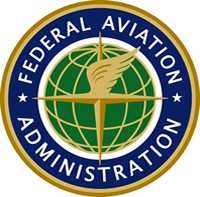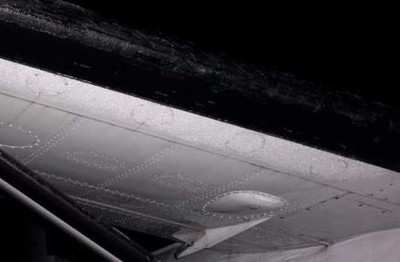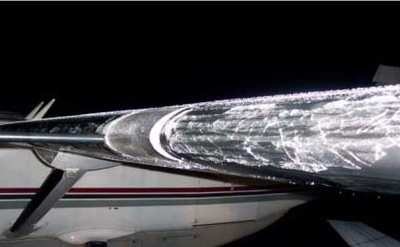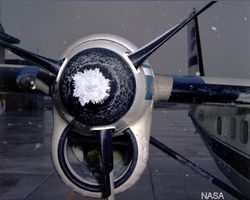Agency Says Numerous ADs And SAFOs Increased Air Safety In
Recent Years
 In the wake of Thursday's
crash of
Continental Connection flight 3407 into a
Buffalo, NY suburb, and in particular the speculation regarding the
role icing may have played in the tragedy, the Federal Aviation
Administration on Friday released a summary of numerous short-and
long-term safety actions it has taken over the past 15 years to
improve safety of aircraft that encounter icing conditions on the
ground and in flight:
In the wake of Thursday's
crash of
Continental Connection flight 3407 into a
Buffalo, NY suburb, and in particular the speculation regarding the
role icing may have played in the tragedy, the Federal Aviation
Administration on Friday released a summary of numerous short-and
long-term safety actions it has taken over the past 15 years to
improve safety of aircraft that encounter icing conditions on the
ground and in flight:
Background
Since 1994, the FAA has issued more
than 100 airworthiness directives to address icing safety issues on
more than 50 specific aircraft types. These orders cover safety
issues ranging from crew operating procedures in the icing
environment to direct design changes. The FAA also has changed
airplane flight manuals and other operating documents to address
icing safety, and issued bulletins and alerts to operators
emphasizing icing safety issues.
In addition to many short-term
initiatives, the FAA has issued one final rule, has another in
final executive coordination, and two proposed rules under
development that address NTSB recommendations.
FAA Actions
The following FAA actions have reduced
icing-related accidents:
-
 In
1996, the FAA mandated (AD 96-09-25) an Airplane Flight Manual
(AFM) revision to limit or prohibit the use of various flight
control devices and provide flight crews with recognition queues
and procedures for exiting from severe icing conditions.
In
1996, the FAA mandated (AD 96-09-25) an Airplane Flight Manual
(AFM) revision to limit or prohibit the use of various flight
control devices and provide flight crews with recognition queues
and procedures for exiting from severe icing conditions.
- In 1999, the FAA issued an Airworthiness Directive (AD
99-19-18) that mandated revisions to AFM to advise flight crews to
activate airframe pneumatic de-icing boots at the first sign of ice
accumulation.
- The FAA has issued ADs on aircraft such as the Mitsubishi MU-2
and the Cessna 208, given their history of icing-related accidents
and incidents.
- On March 29, 2006, the FAA issued Safety Alert for Operators
(SAFO 06002) on ground deicing practices for turbine airplanes in
nonscheduled Part 135 and Part 91 service.
- On October 6, 2006, the FAA issued a Safety Alert for Operators
(SAFO 06014) to warn against the hazards posed by polished
frost.
- On November 11, 2006, the FAA issued a Safety Alert for
Operators (SAFO 06016) to increase awareness of in-flight icing
dangers for pilots flying turbo-propeller powered airplanes.
- On November 30, 2007, the FAA issued Safety Alert for Operators
(SAFO 07009) to inform owners, operators, and FAA entities of
training requirements for pilots of CE-208 (Cessna Caravan 1) and
CE-208B (Cessna Grand Caravan) airplanes for flight into icing
conditions.
- In December 2007, the FAA issued Advisory Circular (AC 91-74A)
on the affect of ice crystals on turbine engines.
- On May 8, 2008, the FAA proposed a rule to remove language from
its regulations that allowed some operators - not commercial
airplanes - to operate with polished frost. Unlike commercial
airplanes which must have a clean wing, corporate aircraft were
permitted to fly with smooth or "polished frost." That practice has
been deemed unsafe. The comment period closed August 6, 2008.
- On May 20, 2008, the FAA issued Safety Alert for Operators
(SAFO 0812) on aircraft taxi operations during snow and ice
conditions.
- On February 11, 2009, the FAA issued Safety Alert for Operators
(SAFO 09004) to emphasize preflight and in-flight planning for
winter airport operations for taxi, takeoff, and landing. It also
elaborates on SAFO 0812.

Proposed New Rule Mandates Icing
Detection
On April 26, 2007, the FAA proposed a
rule to require an effective way to detect ice buildup or let
pilots know that icing conditions exist, and produce timely
activation of the ice-protection system. It would help avoid
accidents and incidents where pilots are either completely unaware
of ice accumulation or think the icing is not significant enough to
warrant turning on their ice-protection equipment. This rule would
mandate that future airplane designs use one of three methods to
detect icing and activate the ice-protection system:
- An ice-detection system that automatically activates or alerts
pilots to activate the ice-protection system
- A definition of visual signs of ice buildup on a specified
surface (e.g., windshield wiper post or wings) combined with an
advisory system that alerts the pilots to activate the
ice-protection system
- Identification of temperature and moisture conditions conducive
to airframe icing that would be used as a cue by pilots to activate
the ice-protection system.
The rule would further require that
after initial activation of the ice-protection system, the system
must operate continuously, automatically turn on and off, or there
must be an alert to tell pilots when the system is to be cycled.
The comment period closed July 25, 2007. The rule is currently in
the final stages of executive review.

Final Rule Introduces New
Airworthiness Standards
On August 8, 2007, an FAA final rule
introduced new airworthiness standards for the performance and
handling characteristics of transport airplanes in icing
conditions. The new rule improves the level of safety for new
airplane designs when operating in icing conditions, and will
harmonize the U.S. and European airworthiness standards for flight
in icing conditions.
The rule adds a comprehensive set of
airworthiness requirements that manufacturers must meet to receive
approval for flight in icing conditions, including specific
performance and handling qualities requirements, and the ice
accretion (size, shape, location, and texture of ice) that must be
considered for each phase of flight. These revisions will ensure
that minimum operating speeds determined during the certification
of all future transport airplanes will provide adequate maneuvering
capability in icing conditions for all phases of flight.
Rules Under Development
 The FAA is
developing a proposed rule change under which air carrier airplanes
are operated that would require either the installation of ice
detection equipment or changes to the procedures for activating the
ice-protection system to ensure timely activation of the
ice-protection system. This proposed rule would apply to all
current and future airplanes in service with air carriers whose
maximum takeoff weight is less than 60,000 pounds.
The FAA is
developing a proposed rule change under which air carrier airplanes
are operated that would require either the installation of ice
detection equipment or changes to the procedures for activating the
ice-protection system to ensure timely activation of the
ice-protection system. This proposed rule would apply to all
current and future airplanes in service with air carriers whose
maximum takeoff weight is less than 60,000 pounds.
The FAA is also developing a proposed
rule to address supercooled large drop icing, which is outside the
icing envelope considered by the current icing certification
requirements. The proposed rule would improve safety by
taking into account supercooled large-drop icing conditions for
transport category airplanes most affected by these icing
conditions, mixed-phase and ice-crystal conditions for all
transport category airplanes, and supercooled large drop, mixed
phase, and ice-crystal icing conditions for all turbine
engines. An economic analysis is currently being prepared.
 Lockheed Hands Over Completed Artemis II Spacecraft
Lockheed Hands Over Completed Artemis II Spacecraft NTSB Final Report: Pulsar Super Pulsar
NTSB Final Report: Pulsar Super Pulsar Classic Aero-TV: Van Horn Rotor Blades -- Tail Rotor Replacements For Bell's 206
Classic Aero-TV: Van Horn Rotor Blades -- Tail Rotor Replacements For Bell's 206 ANN's Daily Aero-Term (05.02.25): Obstacle
ANN's Daily Aero-Term (05.02.25): Obstacle Aero-News: Quote of the Day (05.02.25)
Aero-News: Quote of the Day (05.02.25)







